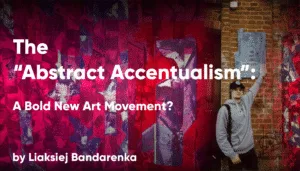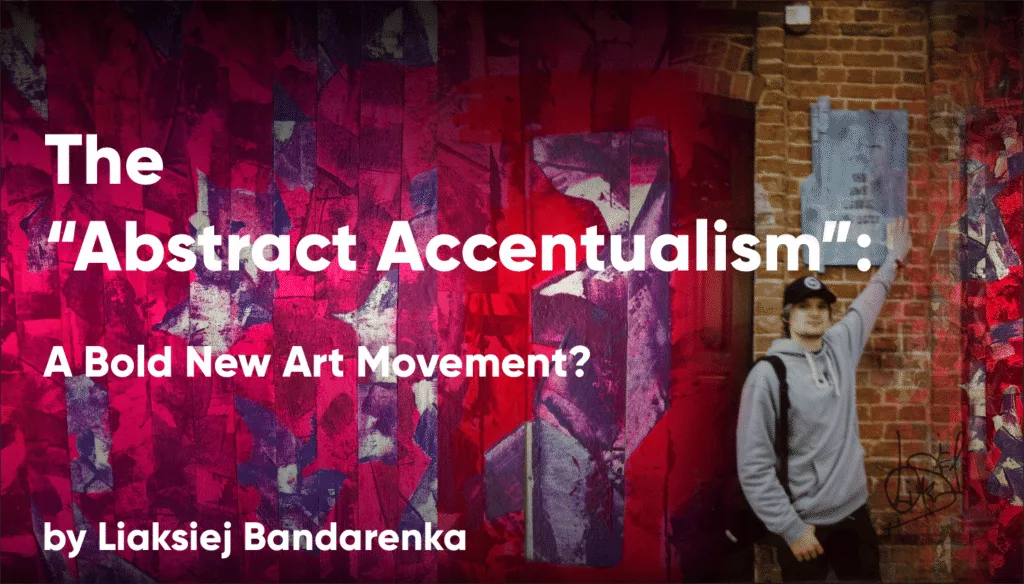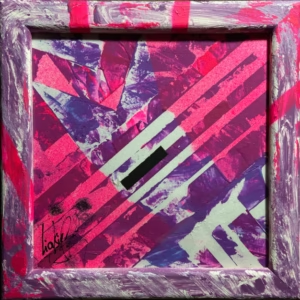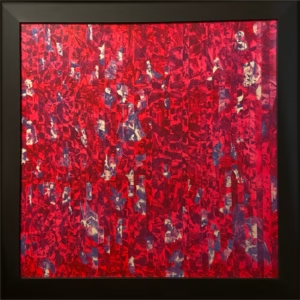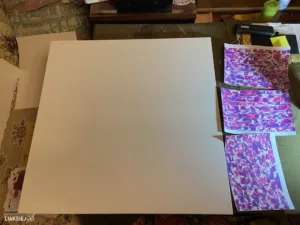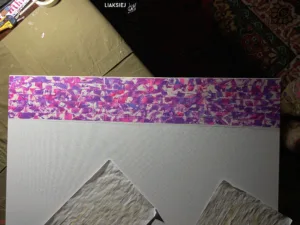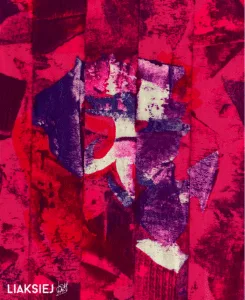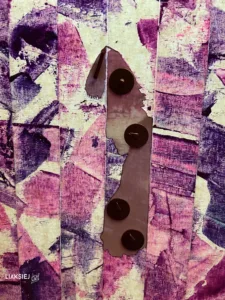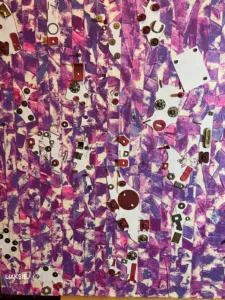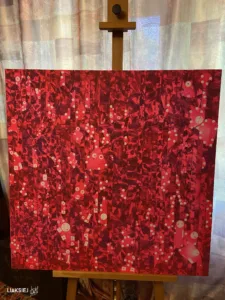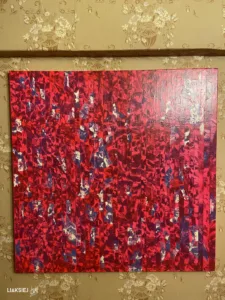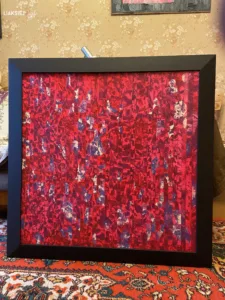The “Abstract Accentualism”: A Bold New Art Movement?
INTRODUCING
- My name is Liaksiej Bandarenka, and I’m a contemporary artist. This text is dedicated to the new Art Movement in abstract art, in which I am actively involved in its creation.
- I’ll present a statement, explain my perspective, unveil the essence of Abstract Accentualism, recount the story behind the creation of this style, and provide examples through my artwork. I’ll also talk about whether the art movement “Abstract Accentualism” holds any symbolic meaning and share my thoughts on whether my artistic technique has the potential to gain recognition in the world of contemporary art.
My Statement on Abstract Accentualism
- I’ve created an artistic movement that I like to call Abstract Accentualism. I have delayed making this decision for quite some time and believe there is no value in continuing to keep this opinion to myself.
- Abstract Accentualism emphasizes highlighting specific objects within the abstract chaos originally portrayed in the painting. This is about instilling integrity in a painting through the consistent application of the artistic technique I developed. This represents a distinctly different method for preparing and creating an abstract painting. This is a liking for a specific mix of colors. Abstract Accentualism is about the complex process that makes abstraction – the result of long routine work, not momentary nonsense. This art form demands imagination not only from the viewer but also from the creator, as it plays a critical role in completing the work. The ultimate beauty of the abstract painting is heavily influenced by the quality of the artist’s creative vision.
- “This is a new artistic direction that I am committed to championing throughout my lifetime, ensuring that it will thrive and leave its mark in the history of World Art long after I am gone.”
- With these thoughts, I find it comforting to fall asleep in the morning, and upon waking in the afternoon, reality seamlessly restores everything to its place. This space is exclusively within the art studio, where “Abstract Accentualism” comes to life.
- This statement and article aim to formalize and substantiate “Abstract Accentualism” as a viable movement and style within abstract art, deserving of broader recognition and dissemination.
- What leads me to this conclusion?
- I haven’t identified anything within the realm of World Abstractionism that replicates my technique, shares similar principles of creation, or mirrors my approach to emphasizing objects as executed in my paintings. Therefore, I regard Abstract Accentualism as a distinct and independent movement within contemporary art.
- Am I entitled to introduce a new artistic movement?
- As I am not an art critic, I do not possess the authority to validate a new artistic style within the global framework of artistic standards. I do not possess the expertise or authority of a journalist and therefore cannot formally declare the emergence of a new movement in abstract art. I am neither a curator nor a director of an exhibition hall or art gallery, and therefore not in a position to make an authoritative statement about Abstract Accentualism. Sometimes it feels like I have no rights in this Modern Age, where institutionalized competence seems to matter more than people. But I know that one of the unique traits of humans, gifted to us by God, is the ability to name everything new and unfamiliar in the world around us. In line with this, I believe I have the right to define a new direction in art for my distinctive works, and I fully embrace the responsibility for this decision and any resulting consequences.
- When and how did this artistic style originate?
- Abstract Accentualism originated in early 2022 during a series of experiments with various mediums, including watercolor, fabric acrylic, traditional artist acrylic, spray acrylic, and gouache. This artistic style fully took shape in May 2022.
Periodization:
- Playing around with paints
- At the start of 2022, I dedicated time to experimenting with watercolor mixing. Gradually, I began incorporating acrylic designed for fabric into the watercolor, eventually expanding my process to include spray paints.
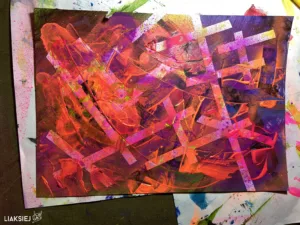
Paint experiments in 2022
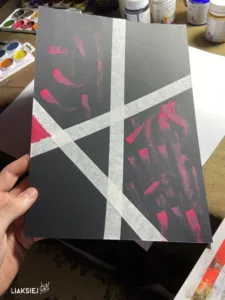
Paint experiments in 2022
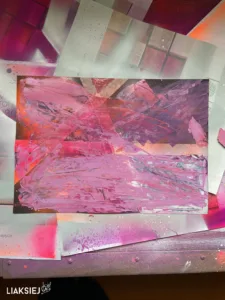
Paint experiments in 2022
- Getting MTN WB Fluorescent Fuchsia at the art store felt like a big step in developing my style of Abstract Accentualism. At home, I still had a can of MTN 94 RV-245 Cyan from 2019, untouched until now. Together, these colors are set to have a major impact on my work.
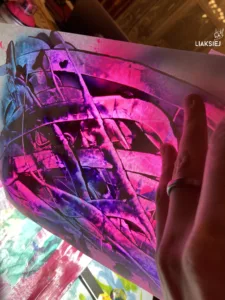
The mix of cyan and bright fuchsia colors
- My experience with Montana 94 and Montana WB spray paints
- I kept mixing the paints like crazy, hoping to create a beautiful, random abstract shape. This time, I really enjoyed working with just two colors, and for a while, I forgot about everything else. I noticed that MTN WB Fluorescent Fuchsia, being water-based, had a certain lightness and transparency to it. On top of that, mixing fuchsia and cyan created a unique range of tones, which will play an important role in my Abstract Accentualism.
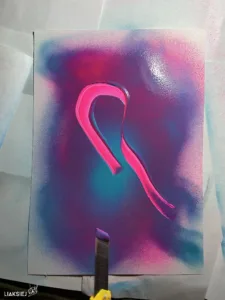
Combining cyan and fuchsia colors on paper
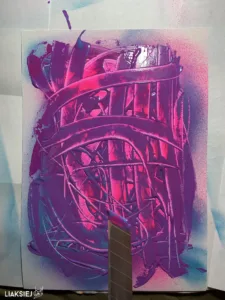
Combining cyan and fuchsia colors on paper
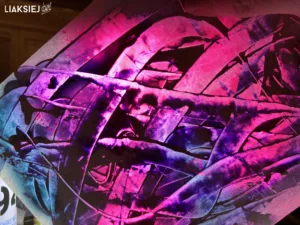
A blend of cyan and fuchsia colors shining through lamplight
- I splashed pink and blue paint onto a blank sheet of white paper, letting the colors collide and blend as I worked them together with a craft knife, creating bold, unpredictable patterns right on the surface. I started wiping the leftover paint on regular A4 paper that I’d been using as protective lining, and after a while[I’m using these sheets of paper to create abstract postage stamps for my NFT collection, Liaksiej.Philately], I switched to wiping it on drawing paper, where I also stuck down some masking tape. This draft ended up becoming my first painting in Abstract Accentualism, titled Queen of Justice.
- After creating some randomness, I kept going and started covering the areas with whatever objects I could find.
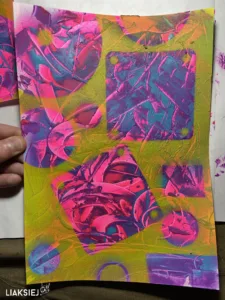
Paintings that experiment with cyan and fuchsia tones, set against a yellow or white background
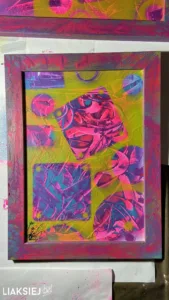
In a wooden frame
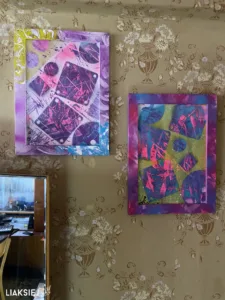
In a wooden frame
- Afterward, I realized the yellow background made the composition look too harsh and wasn’t easy on the eyes. White or gray didn’t work either — they just didn’t fit. The solution, though, was right in front of me. MTN WB Fluorescent Fuchsia, a water-based option, gave the perfect balance of transparency and tied the composition together with its color.
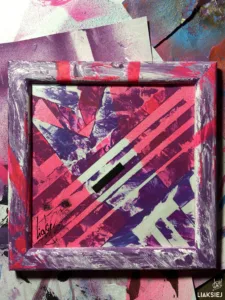
“Queen of Justice”
- The outcome was an unintended side effect, and Queen of Justice was created.
- I’ve got a detailed article on my website about “Queen of Justice” and how it became the first painting in the style of Abstract Accentualism.
- Feel free to check it out here!
- And here I’ll explain it a bit more simply
- The square paper on which I wiped the remnants of the pink and blue paint mixture began to take on a seemingly indecipherable form at first glance.
- However, I started to identify distinct objects within the composition.
- I then chose to isolate these objects, allowing them to stand out independently from the overall chaos of random strokes.
- To achieve this, I applied paint to the entire drawing, leaving only these distinct objects untouched, emphasizing their individuality.
- Here are the outcomes of this
- Simultaneously, the painted field possesses a transparency that enables the viewer to discern and observe other objects.
- – At that time, I had not yet considered the possibility that this represented a fundamentally new artistic style, so the idea of naming it did not cross my mind.
- I had to try out 6-7 paintings to fine-tune my technique and see how consistent the results would be. It took a few months for that to happen.
- In June 2022, I prepared an A4-sized paper, departing from the previously square format. On this paper, I wiped the paint residue from my stationery knife while experimenting with cyan MTN and pink MTN WB colors. Similar to the earlier piece, I applied the colors in two stages, utilizing masking tape to achieve the desired effect.
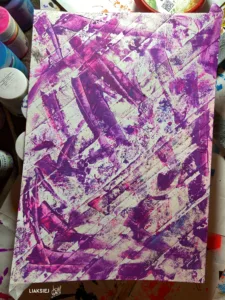
Preparing the materials for the Abstract Accentualism experiment using masking tape and a blend of cyan and fuchsia colors.
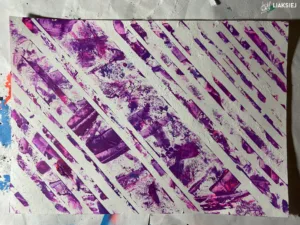
Colored paper mixed for an Abstract Accentualism experiment
- The outcome was a new field, which I then painted yellow in an effort to create more intriguing abstract variations. However, the result left me feeling discouraged, as I believed I had compromised the potential of the future drawing. As a result, I set the paper aside and did not revisit it until January 2023.
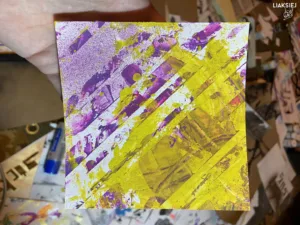
The same paper, now enhanced with a yellow
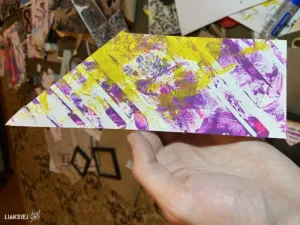
The same paper, now enhanced with a yellow
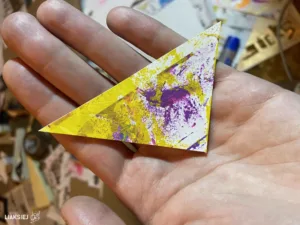
The same paper, now enhanced with a yellow
- In January 2023, I began an experimental process by cutting an A4 sheet into pieces and identifying independent objects within them. Using a protective stencil, I concealed these objects and applied paint to the surrounding areas, creating a unified background that accentuated the objects in the composition. This approach followed the same principle I employed in the painting “Queen of Justice.” However, in this project, I incorporated neodymium magnets to secure the stencils, ensuring precise protection of the objects during the painting process. Through this, my technique evolved and was refined with the integration of new solutions.
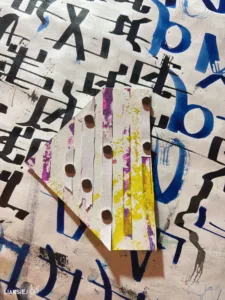
Making miniature paintings with the Abstract Accentualism technique, using paper and magnets to highlight and protect key abstract objects

Applying MTN WB fluorescent fuchsia paint to effectively cover the exposed areas of the artwork
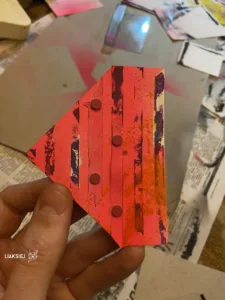
Peeling off the protective paper
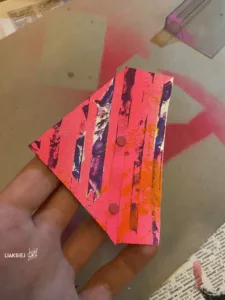
Peeling off the protective paper
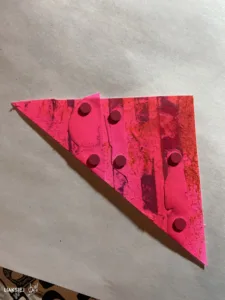
The same way
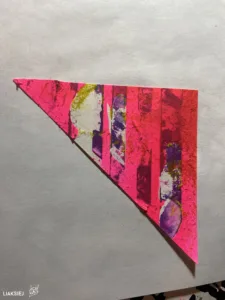
After taking off the protective paper
- As a result, I was able to create the following drawings and frames them within approximately a week. The results were inspiring in their uniqueness, but the next steps remain unclear. I figured it was time to scale things up.
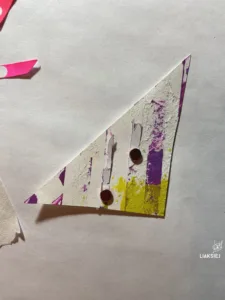
The same way
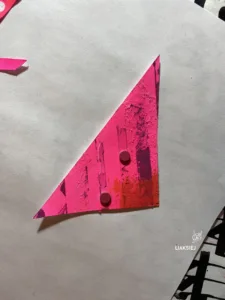
The same way
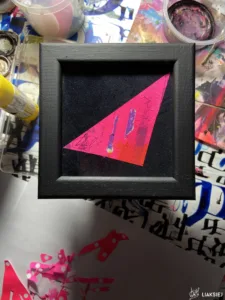
Result
- The trick is to add textures to masking tape and stick it onto the canvas.
- The technique of creating textures with masking tape on Whatman paper
- I wasn’t happy that the paint I was scraping off with a clerical knife didn’t have the cool tone I’d achieved with Queen of Justice, so I decided to give it another shot—this time on a completely different scale and with some new ideas. One of those ideas was switching to canvas. Another was covering the canvas with colored tape and then starting my search for unique artistic elements on this new “canvas.”
- I used A1 paper to create and put together some painted masking tape.
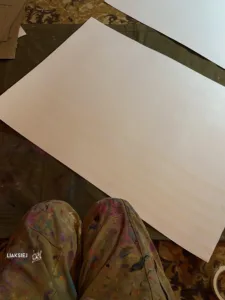
Preparing a white paper for color mixing, with masking tape already applied to divide it into sections
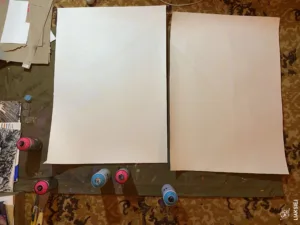
Preparing a white paper for color mixing
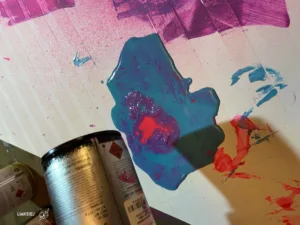
A mix of cyan and fuchsia colors
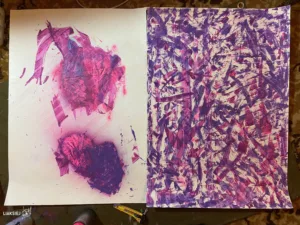
The process of blending cyan and fuchsia colors
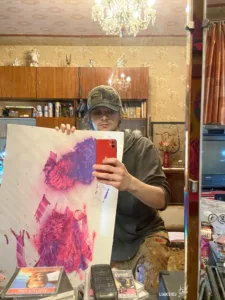
The process of blending cyan and fuchsia colors

The process of blending cyan and fuchsia colors
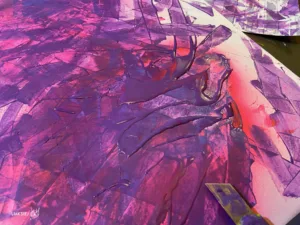
A mix of cyan and fuchsia colors

Peeling off painted tapes
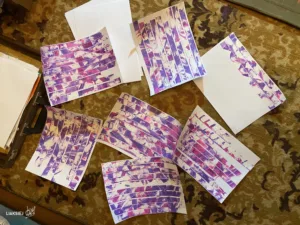
The painted tapes are prepared and ready to be applied to the canvas
- The technique of adhering painted masking tape to canvas in the creation of Infernum I
- I started the process of carefully gluing painted masking tape onto the canvas and then systematically identified individual abstract elements to draw the viewer’s attention to specific areas of the painting. I refer to this as creating an accent.
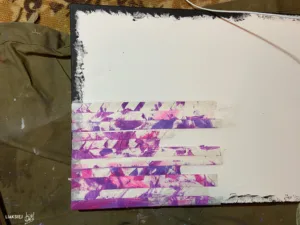
Sticking painted tapes onto a canvas
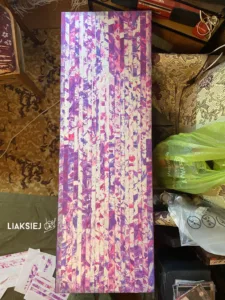
The canvas after finishing up with the painted tape sticking
- The result was Infernum—a place no one should ever attempt to reach. I recognized that these paintings warranted a series, and thus, I titled this piece Infernum I.
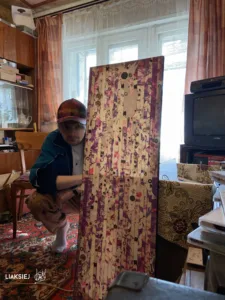
Painting “Infernum I” before applying the main layer of paint
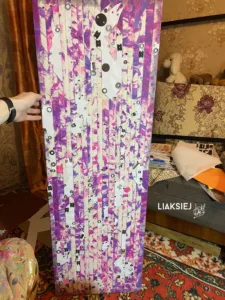
Painting “Infernum I” before applying the main layer of paint
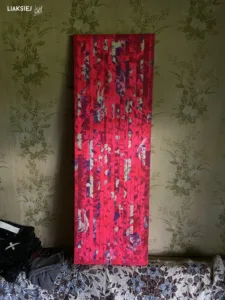
The completed painting “Infernum I”
- The exception to this series is the painting Infernum III, as it is not created in the style of Abstract Accentualism, making it a deliberate exception. A separate article will be published detailing the history of this painting.
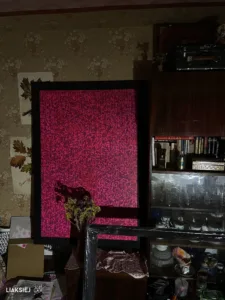
Painting “Infernum III”
- Key lessons from this phase of the art experiments
- Infernum I has finally confirmed that my technique is both viable and effective, requiring endurance, focus, a vivid imagination, caution, and the use of specialized materials. Within the realm of abstraction, this technique stands out as a truly unique phenomenon.
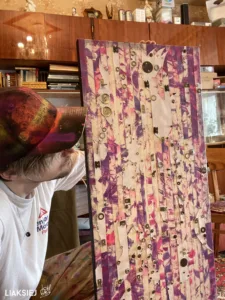
Abstract objects outlined beneath protective paper prior to applying the primary layer of paint
- At the time Infernum I was created, I wasn’t sure what to call this style. I needed more time to analyze and understand my work.
- When the moment finally came, I decided to name my style – Abstract Accentualism. My approach emphasizes individual objects within the overall composition, ensuring they stand out against the general background. These objects are selected from a field of textures — textures that initially present as an abstract chaos of interwoven colors, indecipherable to the eye. Chaos, from which individual objects gradually emerge during the process of work—each object, as I identify it, becomes what I refer to as an accent. Through the careful placement of these accents, a composition takes shape where the viewer’s attention is ultimately drawn to these highlighted elements, which define the essence of my painting.
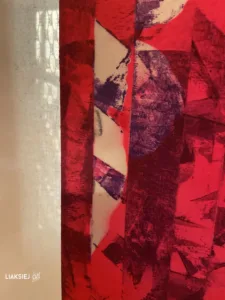
Abstract elements emphasized within the painting “Infernum I”
What is the central concept of Abstract Accentualism?
- The concept of emphasizing a distinct object amidst the indistinct chaos within the overall composition of an abstract painting. Within this chaos, objects emerge, each framed by uniform color borders that serve a dual purpose: acting as a backdrop for the overall composition while highlighting each object as distinct and independent. This technique directs the viewer’s attention to key focal points within the painting, creating intentional accents that stand out amidst the abstract environment.
- To articulate the concept and purpose of my artistic direction, I utilize a classification framework that encompasses both technical and symbolic elements.
Technical component
- Identifying and applying accents to a painting.
- Abstract Accentualism relies on identifying distinct, independent objects within the spaces of an abstract painting to emphasize and highlight them further.
Symbolic component
- The creation of the “Infernum” painting series
- The “Infernum” painting series ended up being the main representation of what I associate with the artistic style of Abstract Accentualism. “Infernum” represents abstract depictions of Hell, serving as a portrayal of a place none should seek to reach. For me, this really has a strong symbolic side that raises individual human fears.
- Enhancing abstract thinking and fostering a richer imagination.
- The awakening of inner anxiety and fear within an individual, which they have yet to confront, is a profound experience. Abstraction has the unique ability to bring to the surface deep thoughts, concepts, and images, encouraging self-reflection and enabling a deeper analysis of oneself. This process can elevate an individual to a higher level of understanding and awareness. In my view, the potential of abstraction in this regard is often undervalued, with its role in facilitating introspection and extracting insights from the imagination remaining largely underappreciated. I believe that the significant influence of mass culture on society hinders the critical calibration necessary for the global art community, ultimately reducing the quality of discourse and criticism surrounding abstract art.
- Introducing my new concept of “Abstract Accentualism,” I acknowledge that it will not resolve the inherent systemic flaw that has existed in Abstractionism since its inception. The practical engagement of one’s imagination with an abstract painting—one devoid of a predefined image, narrative, or symbolism—triggers a process fundamentally different from that of classical art, with its ontological depth and grandeur.
- The value of abstraction lies in its role as a distinctive intellectual form, holding a significant and unique place within the realm of art.
- However, in practice, I fail to see it. From my perspective, there is an overemphasis on abstraction, especially within the context of fashion. This often involves an intensified focus on conceptualization, seemingly to impose meaning onto the work, yet without pursuing any noble or elevated purpose for the artwork itself.
How Does Abstract Accentualism Differ from Other Forms of Abstract Art?
- A range of colors is specified [but the range is not a constant]
- Currently, I work with two spray paint colors: MTN 94 RV-245 and MTN WB Fluorescent Fuchsia. I blend these colors to create an abstract field on the canvas, which serves as the foundation for identifying independent objects within the composition. Additionally, I use MTN WB Fluorescent Fuchsia to apply the final background, covering the entire painting except for the independent objects. This approach creates the “Accents” that define the piece.
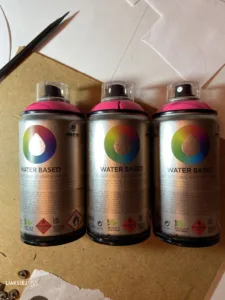
MTN Water Based Fluorescent Fuchsia
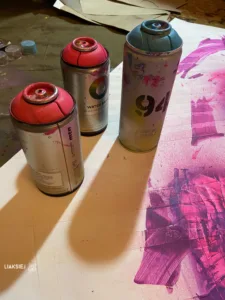
MTN WB Fluoescent Fuchsia with MTN 94 RV-245 Cyan
- Emphasis on objects within a randomized abstract composition of blended colors
- Accents are key components of the painting, functioning as distinct and independent elements. Identifying these accents is a key technical aspect in the process of creating a painting in the style of “Abstract Accentualism.”
- The use of paper tape or painter’s tape textures has emerged as a key element in the principles of Abstract Accentualism.
- In Abstract Accentualism, painted painter’s or paper tapes, adhered to the work surface, serve as the foundational elements of a composition. This technique is a defining characteristic that sets this artistic movement apart from others.
- The uniqueness of the composition – its unconventional nature
- For instance, the painting may be created on a canvas that serves primarily as a foundation for ribbons with colored textures, which are adhered to its surface. These ribbons are arranged in a mosaic-like composition.
- The importance of spray paint and its exclusive properties
- [however, this is not an absolute truth, and I will assume that achieving a transparent background is possible through alternative methods and with other water-based paints]
- For instance, the background can be filled with more than just colors like Fluorescent Fuchsia or others, and does not have to involve semi-transparent or spray paint. However, in my opinion, the classic execution of Abstract Accentualism features MTN 94 RV-245 Cyan and MTN WB Fluorescent Fuchsia. As such, I remain an admirer of this exceptional manufacturer from Barcelona.
- For the background color in paintings created in the Abstract Accentualism style, I believe MTN WB Fluorescent Fuchsia, with its transparency, will preserve the sense of mystery while adding dynamic energy to the overall composition. A solid, opaque background risks placing excessive emphasis on the highlighted elements, which could compromise the intended effect of my technique. For this reason, I plan to experiment with alternative background options in future works to evaluate their impact on the final result.
What Defines My Painting in Abstract Accentualism?
- Crafting textured, painted ribbons
- Texture materials: [paper, masking tape]
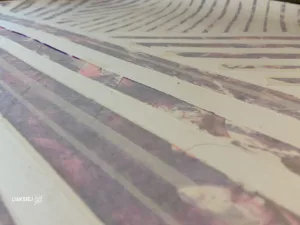
Tape covering the painted section

Adding a blend of colors
- Paints are blended on a sheet of thick paper, with masking tape used to separate areas on the sheet while simultaneously capturing the resulting color combinations. Additionally, masking tape and cut paper strips play a role in constructing the composition of the artwork.
- Preparing and storing texture strips
- The painted sheet of paper gets cut into strips, and just like I do with the masking tape textures, I fold them up and store them away.

Painted tapes are cut and ready for storage
- Preparing the surface for adhering abstract tapes
- The materials I have experimented with for creating my paintings in the style of “Abstract Accentualism” include paper, canvas, and cardboard.

A blank canvas before adding masking tape
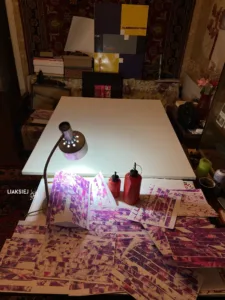
A blank canvas before adding masking tape
- Sticking painted tapes together
- This piece is a compilation of textured, painted ribbons combined to form an abstract field, serving as the foundation for identifying the main objects of the artwork. The assembly is achieved using PVA glue.

Gluing masking tape on canvas
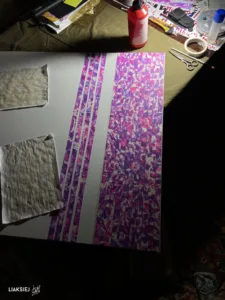
Applying masking tape to canvas
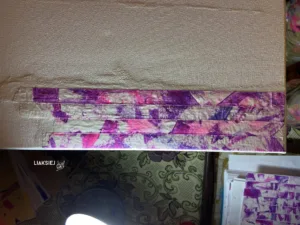
Applying masking tape to canvas
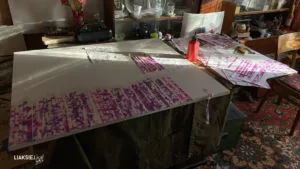
Applying masking tape to canvas
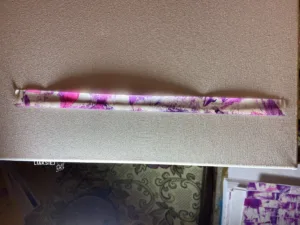
Painted tape
- Seeking specific individual abstract objects
- Extensive and detailed analytical work is conducted to identify valuable independent elements within the painting, ensuring their protection under a paper stencil from external paint during subsequent processes.

Identification of an abstract object
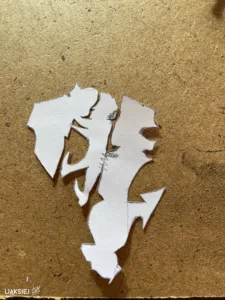
Creating protective paper that’s carefully cut to fit the shape of the object perfectly
- Designing a paper shield stencil
- This step is essential to ensure that when the final layer of spray paint is applied to the entire painting, the individual, independent objects remain untouched. As a result, they stand out within the composition as a deliberate “accent.”
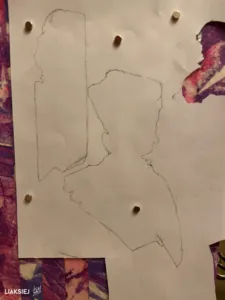
Defining the boundaries of an object for subsequent cutting to serve as protective paper for an abstract object
- Defining the edges of an object on paper
- I use a flashlight behind the painting, along with magnets and a pencil.
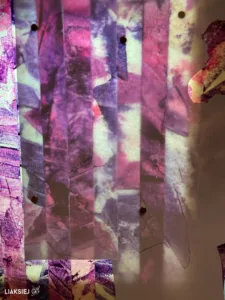
Illuminating the canvas with a lamp positioned on the opposite side
- Creating [cutting] a paper shield stencil
- I used a craft knife to cut the paper to just the right size to protect the unique part of the painting from getting painted over.

The same way [Creating protective paper that’s carefully cut to fit the shape of the object perfectly]
- Installing protective paper stencils
- Using magnets and a variety of small metal components.

Illuminating the canvas with a lamp positioned on the opposite side
- Maximizing the canvas by identifying and filling it with the highest number of distinct, independent objects detected within the painting
- This process appears to be the most time-intensive and requires the greatest number of steps and actions to complete. Moreover, this stage demands significant focus and attention, as well as a strong sense of imagination. It requires thorough analysis of various options before arriving at a final decision on selecting the next object.

Protected Abstract Objects
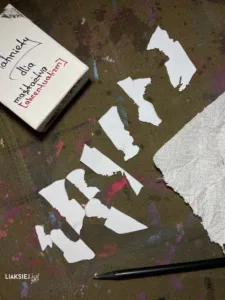

Protected Abstract Objects
- Applying background coverage to a painting
- Once all the stencils are in place to protect the individual, independent objects, I proceed to spray paint the exposed areas of the artwork. This process establishes a cohesive background that unifies the composition while emphasizing the selected objects, which remain shielded under the stencils.

The applied layer of the primary background
- Removing stencils from a painting
- The magnets are detached, and the stencils must then be carefully removed. As they are made of paper, they may adhere to the canvas due to the moisture from the paint. Therefore, careful attention during this process is essential.

Took the retainers off the protective paper [magnets and metal parts]

[magnets and metal parts]
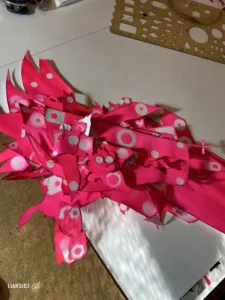
The protective papers
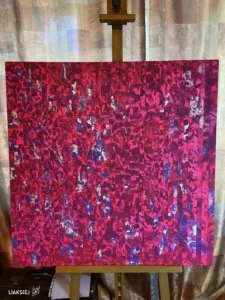
The painting following the removal of protective papers
- Applying Varnish [Parquet Varnish]
- I typically use a matte parquet varnish, however, for the painting Infernum I, I opted for an acrylic matte varnish applied via spray can.

Painting “Infernum II” following the application of varnish
- Preparing a wooden frame for painting
- I use black wooden frames for my paintings, custom-made by a skilled craftsman I collaborate with.
- Placing a painting within a wooden frame
- Framing is a crucial step in completing a painting. I typically prefer black frames, as they provide clear boundaries for the composition and lend a sense of solidity while keeping the viewer’s focus on the central elements of the artwork.

Painting with a wooden frame
Why might the inability to instantly create a painting in Abstract Accentualism be considered an advantage?
- A project cannot be completed instantaneously, it may require several months or even more than a year to reach completion.
- Abstract Accentualism is a time-intensive process, requiring an extended working period during which a wide range of diverse tasks are completed.
- This enables critics to bypass the perception of a work being created hastily, where speed is associated with a lack of depth, purpose, and skill.
What are the limits of possibilities within Abstract Accentualism?
- I do not have a definitive answer to that. My experience with Abstract Accentualism is far removed from final conclusions about the possibilities of this style — what it can represent, the range of color combinations it can employ, and how it creates an abstract field of chaos where objects are identified and emphasized within the composition.
- The technique needs more testing, which gives me plenty of reasons to write another presentation and analysis on Abstract Accentualism.
What is my personal perspective on the future of Abstract Accentualism art?
- The anticipated outcome is the establishment of “Abstract Accentualism” as a distinct and recognized art movement within abstractionism on an international scale..
- I don’t believe it is likely that followers of my “art movement” will emerge. It’s exceptionally challenging for a contemporary individual to dedicate the significant time and effort required to create abstract paintings using my technique. Furthermore, I believe it would be more beneficial for other artists to channel their meticulous efforts into producing works of a higher order — those with an ontological focus and profound meaning, addressing the eternal complexities of human existence on a biblical scale. Such works should strive to portray key themes with the highest level of aesthetic refinement. Personally, I would create such pieces if I possessed the necessary skills.
- In my opinion, Abstract Accentualism is likely to be regarded as an art movement primarily associated with a single author.
- Only time will reveal whether that’s true or not.
- I honestly can’t wait for the day when I have artist-followers creating in the style of Abstract Accentualism, just like I do now.
What steps should be taken if abstract accentualism is not acknowledged by the professional community?
- I remain committed to my work, regardless of any criticism or resistance directed toward me.
Thank you!
Liaksiej Bandarenka
